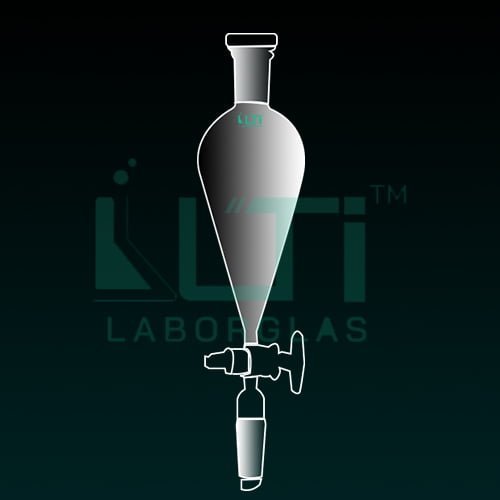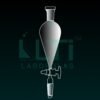- Compliance with ISO 4800 standards
- Without Graduation
- With PE Stopper
| PART No. | Capacity (ml) | NS | Bore (mm) | PACK Qty. |
| 6860-50 | 50 | 19/26 | 2.5 | 1 |
| 6860-100 | 100 | 19/26 | 2.5 | 1 |
| 6860-250 | 250 | 29/32 | 4 | 1 |
| 6860-500 | 500 | 29/32 | 4 | 1 |
| 6860-1000 | 1000 | 29/32 | 6 | 1 |
| 6860-2000 | 2000 | 29/32 | 6 | 1 |
Here are some common uses for such a separating funnel in accordance with ISO standards:
- Liquid-Liquid Extraction:
- The primary function of a Squibb-shaped Separating Funnel is for liquid-liquid extraction, allowing for the separation of immiscible liquids or the extraction of specific compounds from a mixture.
- Sample Preparation for Analysis:
- Laboratories use these funnels to prepare samples for analysis by separating different components or isolating specific fractions for further testing, such as chromatography or spectroscopy.
- Chemical Reagent Addition:
- The solid glass stopcock allows for precise control over the addition of chemical reagents to reaction mixtures, facilitating controlled reactions in chemical processes.
- Phase Separation:
- Squibb-shaped Separating Funnels without graduations are often used in processes where clear phase separation is essential, ensuring the clean separation of different liquid layers.
- Solvent Recovery:
- After a chemical reaction or process, the funnel can be used for solvent recovery by allowing the separation of solvents from the reaction mixture.
- Process Scale-Up:
- These funnels may be used in larger-scale processes or industries where higher volumes are involved. The absence of graduations simplifies the design, making it suitable for different scales of applications.
- Industrial Processes:
- In various industrial settings, Squibb-shaped Separating Funnels with solid glass stopcocks are employed for liquid-liquid separations and extractions.
- Reaction Product Isolation:
- The funnel can be used to isolate and separate products of chemical reactions from reaction mixtures.
- Fractionation:
- In processes where different components of a mixture need to be separated based on their physical properties, Squibb-shaped Separating Funnels can be employed.
- Quality Control Processes:
- Industries use these funnels for quality control processes, especially when precise separations are needed for the analysis of specific components.
- Research and Development:
- Squibb-shaped Separating Funnels without graduations and with solid glass stopcocks find applications in research laboratories for various experiments and processes involving liquid-liquid separations.
- Biological Sample Processing:
- In biological laboratories, these funnels can be used for processing and extracting specific compounds from biological samples.
- Teaching and Demonstrations:
- Educational laboratories may use these funnels for teaching purposes, demonstrating liquid-liquid extraction techniques and the principles of phase separation.







